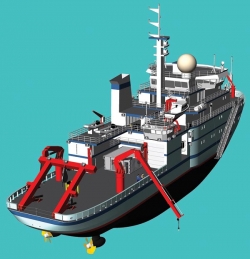The American Recovery and Reinvestment Act of 2009, commonly known as the stimulus bill, includes $400 million for the NSF Major Research Equipment and Facilities Construction (MREFC) account. From this amount, NSF plans to direct more than $100 million to the University of Alaska Fairbanks (UAF) to support construction of the Alaska Region Research Vessel (ARRV), which was approved as a MREFC project in 2007. The final amount of the award is still to be determined.
The ARRV will be a 77 m (254 foot) ice-capable vessel designed to support a variety of research objectives in high latitudes. The ARRV, which will be owned by NSF and operated by UAF on behalf of the ocean sciences community through the University-National Oceanographic Laboratory System (UNOLS), will be the first vessel in the U.S. academic research fleet able to break ice up to 0.75 m (2.5 feet) thick. The ARRV will also be able to:

An aft view of the ARRV, designed by The Glosten Associates in 2004. The ARRV will be capable of year-round operations in seasonal sea ice, near shore, and open ocean regions in the North Pacific, Gulf of Alaska, and Bering, Chukchi, and Beaufort Seas. The ARRV will include 2100 ft2 of laboratory space, a deck working area of 3690 ft2, and be able to accommodate up to four science vans. The vessel's science mission requirements were first developed by UNOLS Fleet Improvement Committee in 1998 and were considered and refined by the vessel's oversight and advisory committees in 2000 and 2001. Rendering by The Glosten Associates, courtesy UAF.
- accommodate up to 26 researchers, including those with disabilities, in addition to a crew of up to 20,
- allow collection of sediment samples from the sea floor,
- host remotely operated vehicles (ROV),
- use a suite of flexible winches to lower and raise sampling equipment through the water column, and
- communicate in real time with classrooms and other outside entities worldwide.
The university released a request for proposals for the vessel's construction in mid-March 2009 with proposals due 30 April 2009. After evaluation of the proposals, final award of a shipyard contract is expected in fall 2009, with science operations beginning in 2013.
At the UAF Seward Marine Center, where the ARRV will be headquartered, the university plans to add a new all-weather dock and additional support facilities; UAF will need to obtain funding for these improvements from a non-federal source.
Planning for the new vessel began more than 30 years ago; it was developed as a replacement for the R/V Alpha Helix, a 133-foot research vessel that was built in 1966, retired after 40 years of service, and sold in 2007 to a private firm for use as a charter research vessel.
The design for the ARRV has been in development since 2000 and has evolved through concept design, preliminary design, and an initial contract design that was completed in 2004 by The Glosten Associates, a group of marine architects in Seattle. In August 2007, UAF entered into a cooperative agreement with NSF to proceed with a project refresh of the 2004 contract design and development of the project documentation needed to support construction. A Final Design Review took place at NSF in October 2008, and in March 2009 the National Science Board authorized the NSF Director, at his discretion, to make awards to UAF for the construction of the ARRV. As of the end of April 2009, UAF had received $18 million through the cooperative agreement.
For more information, see the ARRV website, or contact Dan Oliver (fndko [at] uaf.edu) or Terry Whitledge (terry [at] ims.uaf.edu).
